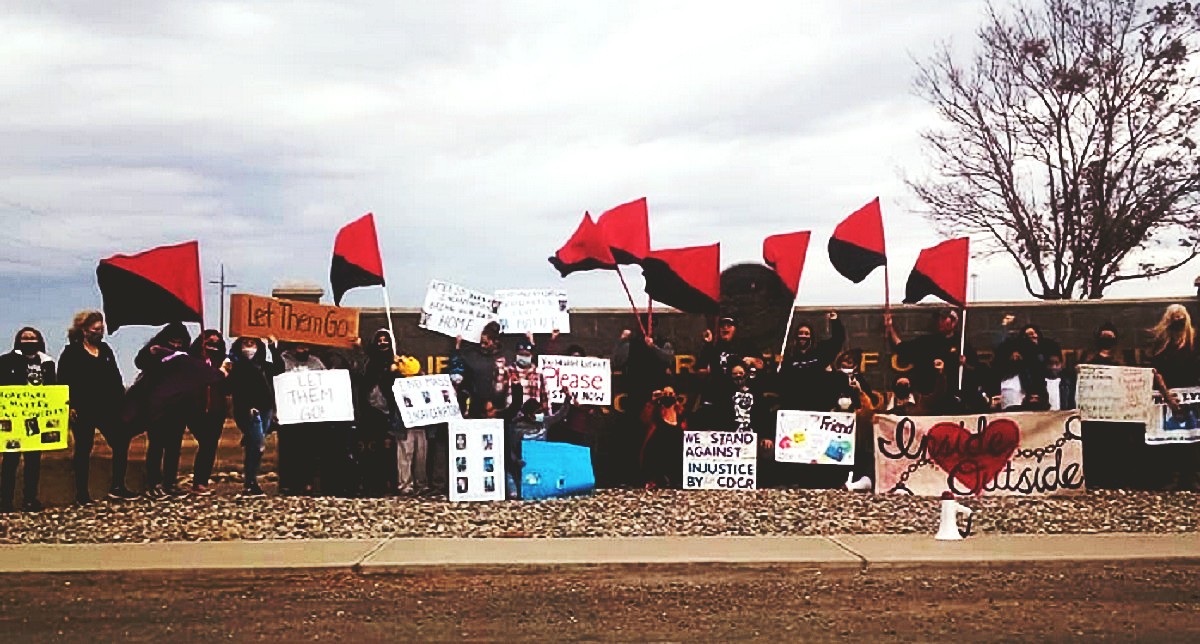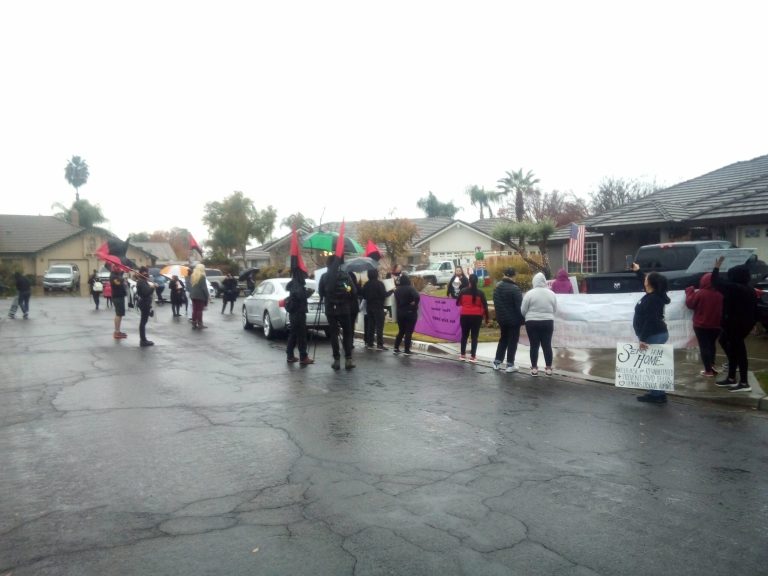Filed under: Action, Featured, Incarceration, Southwest

Report from Perilous Chronicle on wave of protests across Central California against rising pandemic related deaths of prisoners. See Oakland Abolition and Solidarity for more information.
By Ryan Fatica
In the midst of a massive COVID-19 outbreak throughout the California prison system and after a month-long hunger strike at one facility, supporters and family members of prisoners converged on several Valley-area prisons Sunday before staging a demonstration in front of the home of Corrections Secretary Kathleen Allison. The groups were protesting California’s management of the pandemic in the state’s prisons as the death toll rises.
“We are demanding mass release now!” said Renee Benavidez, founder of the prisoner advocacy group We Are Their Voices and co-organizer of the event. “We are demanding CDCR [California Department of Rehabilitation and Corrections] stop the murders that they have all over their hands. We are demanding justice and we want our loved ones brought home.”

Family members of prisoners and activists gather outside the Substance Abuse and Treatment Facility in Corcoran, California to protest the state’s management of the COVID-19 outbreak in the prison system. (Photo Source: Oakland Abolition and Solidarity).
Protesters gathered outside of the California Substance and Treatment Facility (SATF) in Corcoran, California, home to one of the state’s largest outbreaks. Earlier this month, 3 prisoners staged a month-long hunger strike at the facility in protest of the CDCR’s handling of the COVID-19 pandemic.
“Our loved ones are in a life and death situation and CDCR continues to fail to respond in adequate and urgent measure,” said Christine Herrera, whose husband is currently recovering from COVID-19 inside SATF. “We want our loved ones safe; want to bring them home.”
Protesters gathered at or drove by a total of 5 state prisons on Sunday, according to members of Oakland Abolition and Solidarity, one of the prisoner advocacy groups that organized the event. Following the demonstration at SATF, the protest moved to the street in front of Secretary Allison’s home. There, family members spoke of the toll of the virus on their loved ones and placed candles in the shape of a broken heart on Allison’s doorstep, one for each prisoner in her custody killed by the virus.
40 fam and supporters outside SATF-Corcoran on a stormy day!
1 of 6 Central Valley facilities with demonstrations outside them today.https://t.co/fNkdHAQZmx pic.twitter.com/j1zEWhfNF6— Oakland Abolition & Solidarity (@OaklandAboSol) December 13, 2020
In response to a request for comment on the protest at Secretary Allison’s home, Press Secretary Dana Simas reported that the state is taking a variety of precautions to respond to the outbreak. “CDCR and CCHCS are closely monitoring and tracking COVID-19 cases in the state’s 35 prisons,” Simas said in an emailed statement. “We are holding daily calls with department leadership and institution staff to ensure coordination and communication.” Other precautions include distribution of N95 masks, limiting prisoner movement, cancelling visitation, and screening guards and staff for the virus before allowing them to enter prison grounds.
To date, 30,067 people in California’s state prisons have contracted the potentially deadly virus, 97 of whom have died, according to data maintained by the California Department of Correction and Rehabilitation (CDCR). These numbers are rising rapidly, as 9 prisoners in California died of COVID-19 in the first two weeks of December.
The state has also reduced its prison population by more than 25,000 since March. Although the current prison population of about 96,800 is a 30-year low for the state, as the San Francisco Chronicle recently pointed out, that number is still almost five times higher than the 20,000 incarcerated in 1976, when the crime rate was slightly higher than it is today.
Despite these early releases, more of the state’s pre-pandemic prison population eventually contracted the virus than were released. Of the state’s prison population of 122,409 in March 2020, about 21% were released over the course of the year. Of that original population, about 23% eventually tested positive for COVID-19.

Protesters gather outside the home of CDCR Secretary Kathleen Allison (Photo Source: Oakland Abolition and Solidarity).
In fact, the true number of COVID-19 cases in the state’s prisons is likely much higher. Estimates of false negatives produced by PCR testing range from 20%-67%, depending on the stage of illness at which patients are tested. In one study, researchers called the rates of false negatives they found “shockingly high.” Given this reality, the number of prisoners who contracted the virus in the care of the State of California is likely much higher than the number reflected in the official reports.
“I don’t want to die in here,” says Jamie Lien, 62, who is currently incarcerated at SATF. “I’ve heard them say they want this virus to run its course. They want us to get it. They don’t care who dies.”
“The families are helpless in just waiting to see if their husband, dad, son or brother survived it,” said Benavidez. But despite their feelings of helplessness, she said, the families will keep fighting for the lives of the people they care about. “We are families coming from love and anger and protection. We will not stop.”





